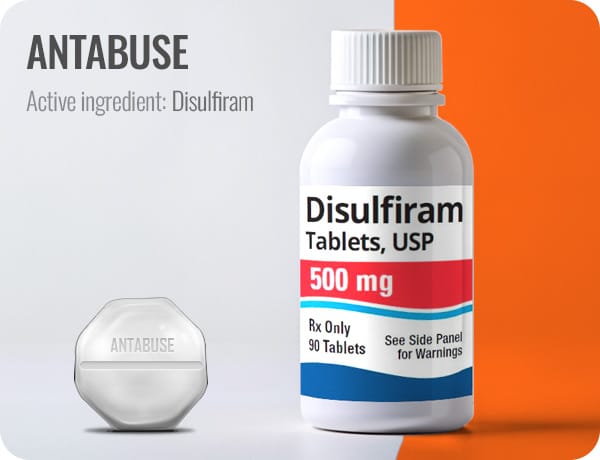Antabuse Interactions: Common Drugs to Avoid.
Understanding Antabuse and Its Purpose in Treatment
Antabuse, scientifically known as disulfiram, represents a seminal advancement in the pharmacological treatment of alcohol dependence. By inhibiting the enzyme acetaldehyde dehydrogenase, Antabuse disrupts the metabolism of alcohol, leading to the accumulation of acetaldehyde, a substance that causes unpleasant effects when alcohol is consumed. This reaction, often referred to as the disulfiram-alcohol reaction, is characterized by symptoms such as flushing, nausea, vomiting, and palpitations, thereby deterring individuals from alcohol consumption. The primary objective of disulfiram therapy is to instill a physical aversion to alcohol, supporting individuals in their journey towards sustained sobriety.
The importance of a comprehensive understanding of Antabuse's mechanism of action cannot be overstated. When alcohol is metabolized in the liver, it is initially converted into acetaldehyde, a toxic compound that is subsequently broken down by acetaldehyde dehydrogenase. By inhibiting this critical enzyme, Antabuse effectively increases the concentration of acetaldehyde tenfold, resulting in the aversive symptoms associated with alcohol intake. This pharmacological intervention serves as a tangible deterrent, leveraging the body's physiological response to discourage alcohol relapse.

Despite its efficacy, the deployment of Antabuse in the clinical setting necessitates a meticulous evaluation of patient suitability and adherence to prescribed guidelines. Its utility extends beyond the mere biological reaction to encompass a psychological deterrent, embedding a conditioned response that fortifies the individual's resolve against alcohol consumption. As such, Antabuse represents not only a pharmacological solution but also a psychological reinforcement, emblematic of the holistic approach required in the treatment of alcohol dependency.
| Aspect | Description |
|---|---|
| Chemical Name | Disulfiram |
| Mechanism of Action | Inhibits acetaldehyde dehydrogenase, leading to increased acetaldehyde levels |
| Primary Use | To support the treatment of alcohol dependency |
| Key Benefit | Creates a physical aversion to alcohol |
| Clinical Consideration | Requires thorough patient assessment and commitment to sobriety |
The Perils of Mixing Antabuse with Alcohol
Disulfiram, known by its brand name Antabuse, operates under a simple yet profound mechanism—it inhibits the enzyme acetaldehyde dehydrogenase, crucial in metabolizing ethanol. When alcohol is consumed on Antabuse, acetaldehyde accumulates in the bloodstream, leading to unpleasant reactions designed to deter the individual from alcohol consumption. These reactions can range from mild discomfort, such as flushing, headache, and nausea, to more severe symptoms, including vomiting, chest pain, and even cardiovascular collapse. This punitive measure forms the cornerstone of Antabuse's utility in the treatment of chronic alcoholism, reinforcing abstinence through the direct physiological consequences of drinking.

The interaction between Antabuse and alcohol is profound and unforgiving, serving as a stark reminder of the importance of strict adherence to antabuse information and guidelines. When alcohol enters the system of someone who has taken Antabuse, the resulting acetaldehyde syndrome can commence within minutes and persist for hours, instilling an immediate and lasting aversion to alcohol. The severity of this reaction is not just discomforting but can pose serious health risks, signaling to patients the critical importance of avoiding any form of alcohol, including those found in some mouthwashes, cough syrups, and even culinary sauces. This reaction underscores the need for patients and healthcare providers to meticulously manage and communicate the potential risks associated with its use.
Educating patients about the comprehensive scope of products containing ethanol is crucial to avoid inadvertent exposure. Alongside medical supervision, an understanding of the pharmacokinetics and pharmacodynamics of Antabuse provides the foundation for a successful recovery pathway. Healthcare professionals must ensure that patients are well-informed of the consequences of mixing Antabuse with alcohol to safeguard against adverse reactions. Such rigorous education and adherence to avoidance can empower individuals in their journey toward sobriety, highlighting the role of responsible medication management in overcoming dependency.
Common Over-the-counter Medications to Avoid
Delving into the world of over-the-counter medications, it's crucial for those under Antabuse treatment to exercise caution. Antabuse, a pharmacological aid used in the management of alcohol dependence, operates by inhibiting the enzyme acetaldehyde dehydrogenase, leading to unpleasant effects when alcohol is consumed. However, the vigilance should not cease at alcoholic beverages; numerous OTC products inadvertently contain alcohol or substances that might interact adversely with Antabuse, demanding a meticulous scrutiny of ingredients before any utilization.

Cold and cough remedies stand at the forefront of OTC medications that necessitate a careful evaluation. Many of these products, marketed for relieving symptoms of the common cold or flu, include alcohol or alcohol-based components. The inclusion of such ingredients can provoke severe Antabuse-alcohol reactions, marked by symptoms such as headaches, nausea, vomiting, and palpitations. Therefore, patients are advised to opt for alcohol-free alternatives and seek guidance from healthcare professionals to ensure the safety and efficacy of their treatment regimen.
Moreover, digestive aids, including certain antacids and laxatives, may also harbor hidden sources of alcohol or interact unpredictably with Antabuse. Such unforeseen interactions underscore the importance of thorough antabuse information gathering prior to incorporating any OTC medication into one's health management plan. Pharmacists can serve as invaluable resources, offering insights into safe product selections that circumvent potential complications.
Ultimately, the journey of navigating the landscape of OTC medications while on Antabuse is one of informed caution and proactive engagement with healthcare providers. By prioritizing an awareness of the constituents within over-the-counter products, individuals can safeguard their health against adverse interactions, ensuring that their path towards recovery remains steadfast and unencumbered by preventable setbacks.
Prescription Medicines That Trigger Adverse Reactions
Navigating the complexities of medication management while on Antabuse requires a nuanced understanding of pharmacological interactions. Various prescription drugs, when taken concomitantly with Antabuse, can precipitate severe and often unexpected reactions. These reactions may be due to the inherent properties of the medications or the resultant inhibition of enzymatic pathways, a cornerstone of Antabuse's mechanism of action designed to deter alcohol consumption. For instance, certain sedatives, notably benzodiazepines, and antidepressants might not only potentiate sedation but also interfere with the metabolic processes, heightening the risk of adverse effects.
Moreover, the realm of antidiabetic medications interwoven with Antabuse therapy presents an intricate tapestry of metabolic challenges. The hypoglycemic effects of sulfonylureas, for example, could be amplified, leading to unforeseen episodes of hypoglycemia. The antabuse information directs healthcare providers to exercise diligence in monitoring blood glucose levels and to adjust dosages accordingly. This delicate balancing act underscores the importance of a collaborative approach in healthcare, ensuring that patients are not only informed but also actively involved in managing potential drug interactions.
Another noteworthy consideration involves the use of anticoagulants, such as warfarin, in patients receiving Antabuse therapy. The interaction between these medications can result in significant alterations in prothrombin time, necessitating meticulous monitoring to avert the risks of bleeding or thrombotic events. The intricate interplay between these drugs emphasizes the essential role of pharmacokinetic knowledge in mitigating adverse reactions.
In conclusion, the landscape of prescription medicine interactions with Antabuse is fraught with potential pitfalls. The elucidation of these interactions not only serves as a testament to the intricacies of pharmacotherapy but also highlights the imperative for vigilant monitoring and personalized care strategies. By staying informed and engaging in open dialogue with healthcare professionals, patients can navigate the complexities of Antabuse therapy with confidence and safety.
Herbal Supplements and Natural Products: Hidden Risks
In the context of managing disulfiram (Antabuse) treatment, an often-overlooked concern is the interaction between this medication and various herbal supplements and natural products. The metabolic pathways through which disulfiram functions can be inadvertently influenced by seemingly innocuous herbal substances, leading to unexpected and sometimes severe adverse effects. For instance, patients might not be aware that herbal products containing alcohol, such as some extracts, can provoke the same reactions as consuming alcohol directly. Therefore, it's crucial for individuals taking disulfiram to scrutinize herbal supplement labels for alcohol content and other potentially reactive components.
Moreover, the enzyme-inhibiting properties of disulfiram may extend to the metabolism of compounds found in certain natural products. This can result in heightened or prolonged effects of those compounds, further complicating the antabuse information landscape for patients. For example, St. John’s Wort, commonly used for depression, can alter disulfiram metabolism, leading to increased concentrations of disulfiram and an elevated risk of adverse reactions. Recognizing these interactions requires a detailed understanding of both prescribed and alternative treatments.
The challenges extend beyond direct interactions. Some herbal supplements can affect liver enzyme levels or mimic alcohol's effects in the body, exacerbating the disulfiram-alcohol reaction or complicating liver function assessments. These factors necessitate a cautious and educated approach to incorporating herbal and natural products into a regimen that includes disulfamily therapy.
| Herbal Supplement | Potential Risk with Disulfiram |
|---|---|
| Herbal Extracts Containing Alcohol | May trigger a disulfiram-alcohol reaction |
| St. John’s Wort | Can alter disulfiram metabolism, increasing adverse effects |
| Supplements Affecting Liver Enzymes | Could complicate the management of disulfiram therapy |
| Kava | Mimics alcohol's effects, potentially exacerbating disulfiram reactions |
Connecting patients with comprehensive antabuse information, including the potential interactions between their medication and alternative therapies, plays an indispensable role in avoiding these hidden risks. It underscores the importance of healthcare providers engaging in thorough discussions about all substances their patients may be utilizing.
Navigating Dietary Considerations: Foods and Drinks to Avoid
When undertaking treatment with Antabuse, a disulfiram-based medication designed to support recovery from alcohol dependence, patients must conscientiously manage their dietary intake, as certain foods and beverages can inadvertently trigger adverse reactions. Individuals must avoid products that contain even trace amounts of alcohol, as Antabuse acts by inhibiting the enzyme acetaldehyde dehydrogenase, leading to an accumulation of acetaldehyde in the blood when alcohol is ingested. This reaction can provoke a range of unpleasant symptoms, including nausea, vomiting, headache, and palpitations, which are intended to deter the consumption of alcohol.
The list of dietary items to avoid extends beyond the obvious alcoholic beverages. Many patients might not be aware that cooking sauces, extracts like vanilla or almond, and some types of vinegar also contain alcohol. Furthermore, fermented foods, such as kimchi and some types of sauerkraut, can contain alcohol as a byproduct of their fermentation process. Even ripe fruits and certain fruit juices can have naturally occurring alcohol due to the fermentation of sugars. These hidden sources of alcohol necessitate a careful review of ingredient labels and, in some cases, consultation with a healthcare provider to ensure no inadvertent exposure.
In addition to alcohol-containing foods and beverages, individuals should exercise caution with mouthwashes, cough syrups, and other over-the-counter products that might contain alcohol. The absorption of alcohol through the mucous membranes in the mouth can be sufficient to trigger a reaction. Thus, opting for alcohol-free versions of these products is advised.
Educating oneself about these dietary considerations is a critical component of treatment with Antabuse. It empowers patients to make informed decisions, avoid triggers, and successfully navigate the challenging path of recovery. Engagement with a healthcare professional can provide personalized guidance tailored to individual needs, ensuring dietary choices support the efficacy of the medication and the overall treatment plan.
Understanding How Antabuse Works Against Alcohol Abuse
The Impact of Antabuse on Your Daily Life
Integrating Antabuse into one's regimen as a therapeutic measure against alcohol dependency marks a significant stride toward sobriety. However, this journey is accompanied by a spectrum of challenges that extend beyond the physiological dimensions, infiltrating daily routines and social interactions. The presence of disulfiram, the active component in Antabuse, conditions the body to deter alcohol consumption by eliciting adverse reactions upon alcohol intake. This mechanism, while effective, necessitates a comprehensive recalibration of one’s lifestyle choices and activities. Social gatherings, cultural events, and rituals that once revolved around alcohol consumption require reevaluation, mandating a shift towards environments and engagements that support recovery and wellness.
The day-to-day life of an Antabuse user is characterized by an increased need for vigilance and awareness, especially in contexts where alcohol is present in unexpected forms, such as in certain foods, medications, and household products. The inadvertent consumption of alcohol in these contexts can trigger the drug's intended reaction, leading to significant discomfort and potential health risks. This necessitates a proactive approach to reading labels and communicating dietary restrictions in both personal and public settings, fostering a lifestyle that prioritizes safety and well-being.
Moreover, the transition to a lifestyle supported by Antabuse also encompasses psychological adaptations. Individuals may experience shifts in their social dynamics, as relationships previously anchored in shared alcohol consumption undergo transformation. The process of navigating these changes can evoke emotions ranging from isolation to empowerment, highlighting the importance of integrating supportive therapies and community engagement into the recovery process.
To mitigate these disruptions and foster a conducive environment for recovery, individuals are encouraged to adopt strategies that align with their treatment objectives. Structuring social activities around sober interests, engaging in recovery groups, and developing open communication channels with healthcare providers about the challenges faced can significantly enhance the effectiveness of Antabuse in the journey towards maintaining sobriety. Through such strategic adaptations, individuals can navigate the complexities of daily life on Antabuse, harnessing its potential as a catalyst for lasting change.
Interactions with Other Medications and Substances
Antabuse, a cornerstone in the pharmacological management of alcohol dependence, operates through a unique mechanism that deters alcohol consumption by inducing unpleasant effects when alcohol is ingested. However, its capacity to alter enzyme activity extends beyond the metabolism of alcohol, necessitating a careful consideration of potential interactions with other medications and substances. Concomitant use of Antabuse and certain medications can either potentiate adverse reactions or diminish the efficacy of either substance. For instance, the simultaneous administration of Antabuse with metronidazole or paraldehyde can provoke confusional states or even psychosis, highlighting the critical need for meticulous medication reconciliation prior to initiation.
Moreover, the influence of Antabuse on liver enzyme systems can lead to altered pharmacokinetics of other drugs, altering their metabolism and magnifying both therapeutic and adverse effects. Understanding these interactions and adjusting dosages accordingly is paramount for the safe and effective use of Antabuse within a comprehensive treatment plan. Additionally, over-the-counter products and dietary supplements should not be overlooked as potential sources of interaction. Substances containing alcohol, such as certain cough syrups or mouthwashes, can precipitate the Antabuse-alcohol reaction, leading to severe discomfort and the potential augmentation of cardiovascular stresses.
In the realm of clinical practice, the management of these interactions is facilitated by a thorough knowledge base and collaborative care approaches. Regular monitoring and patient education play vital roles in navigating the complexities of polypharmacy, ensuring that the therapeutic benefits of Antabuse are not undermined by inadvertent drug interactions. Healthcare providers must engage in open and ongoing dialogue with patients, elucidating the importance of reporting all medications, over-the-counter products, and dietary supplements being consumed.
| Substance Type | Interaction with Antabuse | Recommendation |
|---|---|---|
| Alcohol-containing products | Can trigger severe Antabuse-alcohol reaction | Avoid all products containing alcohol |
| Metronidazole or similar drugs | May cause acute psychosis or confusion | Contraindicated/Use alternative medications |
| Warfarin and other anticoagulants | Potentiation of anticoagulant effect | Monitor coagulation parameters closely |
| Phenytoin | Increased phenytoin levels | Adjust phenytoin dose based on levels and clinical response |
This table underscores the necessity for diligent review and adjustment of concomitant medications in patients receiving Antabuse therapy. By carefully managing these interactions, clinicians can mitigate risks and enhance the safety and effectiveness of treatment for alcohol dependence.
Navigating the Alcohol-antabuse Reaction: Symptoms to Watch
When individuals on Antabuse ingest alcohol, a deliberate and specifically engineered biochemical reaction occurs, aimed at deterring further alcohol consumption. This reaction is a result of Antabuse's mechanism of action, which inhibits the enzyme aldehyde dehydrogenase, crucial in breaking down ethanol. Consequently, when alcohol is consumed, it leads to an accumulation of acetaldehyde in the blood, a toxic substance that produces highly unpleasant symptoms designed to make the consumption of alcohol less appealing. The symptoms of this reaction can begin within ten minutes of alcohol ingestion and may include flushing of the skin, throbbing in the head and neck, respiratory difficulty, nausea, copious vomiting, sweating, thirst, chest pain, palpitations, dizziness, and confusion. In severe cases, hypervention, tachycardia, hypotension, syncope, marked uneasiness, weakness, vertigo, blurred vision, and confusion are observed, necessitating immediate medical attention.

Understanding the spectrum and severity of these symptoms is crucial for users of Antabuse, as it underscores the importance of abstaining from alcohol consumption. These reactions are not only physically uncomfortable but can also be psychologically distressing and potentially life-threatening. The immediate onset and severity of the reaction are directly proportional to the amount of alcohol consumed and the body's sensitivity to Acetaldehyde. Therefore, it is vital for individuals to be fully aware of the potential consequences and to recognize the symptoms promptly.
For healthcare providers and patients, educating about these risks, recognizing early symptoms, and understanding the time frame and severity of the potential reaction are essential components of managing treatment with Antabuse. It empowers patients with the knowledge to navigate their path towards recovery while being acutely aware of the implications of alcohol consumption. Immediate cessation of alcohol intake and seeking medical assistance upon the onset of the reaction are critical steps in avoiding more severe complications.
Long-term Implications of Antabuse Use on Health
Antabuse, a brand name for disulfiram, has been a cornerstone in the treatment of alcohol dependency, functioning by inhibiting the enzyme acetaldehyde dehydrogenase which leads to unpleasant effects upon alcohol consumption. However, when evaluating the prolonged ingestion of disulfiram, it's imperative to scrutinize the ramifications it harbors on an individual's health. Observational studies and clinical trials have illuminated a spectrum of long-term side effects; notably, hepatic toxicity emerges as a critical concern. Given disulfiram’s mode of action in the liver, extended use can precipitate liver enzyme alterations and in rare instances, provoke hepatocellular damage. These hepatic implications necessitate regular monitoring, underscoring the importance of liver function tests during therapy.
Beyond hepatic considerations, neurological sequelae represent another dimension of prolonged disulfiram use. Neuropathy, characterized by weakness, pain, and tingling in the extremities, has been documented in a subset of individuals undergoing treatment with Antabuse. This condition, although often reversible upon discontinuation of the medication, underscores the delicate balance between therapeutic benefits and potential adverse outcomes. The pathophysiological mechanism is thought to involve disulfiram's interference with neurotransmitter metabolism, highlighting a complex interplay between its therapeutic intentions and unintended neurological effects.
Addressing these long-term implications requires a nuanced approach, integrating regular health assessments and a keen attentiveness to the patient's evolving clinical picture. Healthcare professionals play a pivotal role in mediating these effects, advocating for a judicious use of Antabuse, while ensuring that patients are fully apprised of potential health risks associated with prolonged use. Such vigilance ensures that the benefits of abstaining from alcohol are not overshadowed by adverse health outcomes, fostering a therapeutic landscape where the merits of Antabuse can be harnessed effectively, with minimized risk to the patient's long-term well-being.
Managing Side Effects: Tips and Strategies for Users
Navigating the potential side effects of Antabuse involves a strategic approach to minimize discomfort while ensuring the medication's efficacy in discouraging alcohol consumption. Adopting an informed regimen that complements the pharmacological action of Antabuse can enhance the user's overall experience. Initially, hydration is paramount; increasing water intake can alleviate some of the milder side effects, such as headaches and dizziness, by facilitating the metabolic processes required to break down and eliminate the drug from the body. Incorporation of a balanced diet rich in vitamins and minerals also plays a critical role. Nutrients such as vitamin B12, folate, and magnesium can support liver function and overall metabolism, potentially mitigating the risk of adverse reactions.

Furthermore, engaging in regular, moderate exercise can improve physical and mental health, boosting the body's resilience against the stressors of adapting to a life without alcohol. However, it's essential to consult with a healthcare professional before embarking on any new fitness program, especially for individuals with underlying health issues. Effective communication with healthcare providers is crucial in managing the side effects of Antabuse. Regular check-ups allow for monitoring the body's response to the medication and adjusting the dosage if necessary to balance efficacy and tolerability.
The table below summarizes practical strategies for managing side effects:
| Strategy | Description | Benefit |
|---|---|---|
| Hydration | Increase water intake | Alleviates headaches and dizziness |
| Nutrition | Consume a balanced diet | Supports liver function and metabolism |
| Exercise | Engage in regular, moderate activity | Enhances physical and mental resilience |
| Consultation | Regular check-ups with healthcare providers | Ensures appropriate dosing and management of side effects |
Addressing side effects associated with the use of Antabuse requires a thoughtful and proactive approach, integrating both medical guidance and lifestyle adjustments. The foundational step involves thorough communication with a healthcare professional, who can offer insights into mitigating adverse effects. They might suggest dosage adjustments or recommend a tailored schedule for medication intake that aligns with the patient's unique physiological response, thereby minimizing discomfort.
Incorporating nutritional strategies plays a critical role in managing side effects. A diet rich in vitamins and minerals supports the liver's health, enhancing the body's ability to metabolize the medication and reduce the risk of exacerbating side effects. Hydration is equally pivotal; ample fluid intake ensures that the body can efficiently process and eliminate the drug, potentially alleviating symptoms such as headache and dizziness.
Lifestyle modifications can also serve as a robust pillar in this comprehensive strategy. Regular physical activity, for instance, can improve the body's tolerance to the medication, fostering overall well-being and resilience. Equally, relaxation techniques like yoga or meditation can counteract some of the psychological impacts, such as anxiety or mood swings, thereby promoting mental and emotional stability.
Finally, the implementation of a support system cannot be overstated. Whether through support groups, counseling, or family and friends, emotional and psychological backing aids in navigating the challenges of side effects. Such networks provide not only moral support but can also encourage adherence to prescribed treatments and lifestyle adjustments, ensuring a holistic approach to managing the side effects of Antabuse. Through these synergized efforts, patients can achieve a balance, enhancing both their recovery journey and quality of life.
Lastly, recognizing when symptoms may signify more than typical side effects is vital. Understanding the distinction between common reactions and signs of potential complications can ensure timely intervention, preventing more severe health implications. In essence, managing the side effects of Antabuse requires a holistic approach that encompasses lifestyle adjustments, dietary considerations, and proactive healthcare engagement, tailor-made to support each individual's journey towards recovery from alcohol dependence.
Common Side Effects of Antabuse You May Experience
Antabuse, a medication widely recognized for its employment in the management of chronic alcoholism, produces a set of common side effects that individuals embarking on this treatment should be aware of. While the therapeutic mechanism of Antabuse serves as a deterrent against alcohol consumption by inducing unpleasant effects upon alcohol intake, the medication itself can bring about several reactions independent of alcohol interaction. These side effects range from mild to severe and include fatigue, skin eruptions, and a metallic or garlic-like aftertaste, all of which are the body's responses to the presence of the drug. The manifestation of such side effects underscores the importance of patient education and preparedness in the course of treatment.
Moreover, users may encounter drowsiness, headache, and impotence, which, although less common, pose significant concern due to their impact on daily functioning and quality of life. The physiological basis for these reactions involves Antabuse's interference with the body's enzyme systems, notably those involved in the metabolism of alcohol, which can have a cascading effect on various bodily processes. Understanding the biochemical pathways affected by Antabuse is crucial for healthcare providers to accurately anticipate and manage these potential side effects.
Additionally, gastrointestinal disturbances such as nausea, vomiting, and a loss of appetite are frequently reported by individuals taking Antabuse. These effects, while often temporary, can lead to decreased medication adherence and thus compromise the efficacy of the treatment regimen. It is imperative that patients are counseled on strategies to mitigate these effects, such as taking the medication with food or at bedtime, to enhance tolerability and ensure the success of their recovery journey.
In the broader scope of patient care, the recognition and management of Antabuse’s side effects are paramount. The healthcare team must maintain a vigilant stance, regularly evaluating the patient's tolerance to the medication and adjusting the treatment plan as necessary. By fostering open communication and providing comprehensive support, healthcare professionals can help patients navigate the challenges of Antabuse therapy, thereby optimizing outcomes and empowering individuals in their pursuit of sobriety.
Antabuse, known scientifically as disulfiram, operates on a simple yet profoundly effective principle to combat alcohol abuse. The mechanism at its core involves inhibiting the enzyme aldehyde dehydrogenase (ALDH), which is crucial in the metabolic breakdown of ethanol in the liver. Under normal circumstances, ethanol is first converted to acetaldehyde, a compound notorious for its toxic and unpleasant effects, before being further metabolized to acetate by ALDH. By blocking ALDH's action, Antabuse causes an accumulation of acetaldehyde in the blood, leading to a series of adverse effects upon alcohol consumption that are intended to deter the individual from further drinking. This aversive therapy, while straightforward in its biochemical underpinnings, leverages a robust understanding of metabolic pathways to provide a tangible deterrent against alcohol consumption.
| Chemical | Role | Effect When Inhibited |
|---|---|---|
| Ethanol | Primary alcohol consumed | Initial substrate in metabolic pathway |
| Acetaldehyde | Toxic intermediate | Accumulates causing adverse effects |
| Acetate | Final, non-toxic metabolite | Production delayed, increasing toxicity |
The elegance of Antabuse therapy lies not only in its direct biochemical intervention but also in its psychological deterrent effect. As individuals treated with Antabuse know the unpleasant, potentially severe reactions that alcohol consumption can trigger, many develop a conditioned aversion to alcohol over time. Such an aversive response is a critical step in the journey towards recovery, reinforcing sobriety by associating alcohol intake with negative physical symptoms. Moreover, the effectiveness of Antabuse is enhanced when combined with counseling and support groups, indicating the multiplicative potential of integrating pharmacological solutions with psychological and social support mechanisms in the treatment of alcohol dependence. This comprehensive approach underscores the importance of understanding the biological, psychological, and social dimensions of addiction to effectively combat it.
Antabuse Side Effects: What You Need to Know
Understanding How Antabuse Works in Your Body
Antabuse, chemically known as disulfiram, operates on a simple yet profoundly effective mechanism within the human body aimed at deterring alcohol consumption. Upon ingestion, disulfiram inhibits the enzyme aldehyde dehydrogenase (ALDH), critical in the metabolic breakdown of ethanol, alcohol's active ingredient. Typically, ethanol is first metabolized into acetaldehyde, a toxic compound that's further broken down into harmless acetic acid by ALDH. By blocking the action of ALDH, Antabuse causes an accumulation of acetaldehyde in the blood to 5-10 times the normal concentration, leading to unpleasant and potentially severe reactions if alcohol is consumed.
Here's a quick overview of how this process works:
| Step in Metabolic Pathway | Normal Condition | Under Antabuse |
|---|---|---|
| Ethanol intake | Metabolized to acetaldehyde | Same as normal |
| Action of ALDH | Acetaldehyde converted to acetic acid | Conversion blocked, acetaldehyde accumulates |
| End result | No adverse reaction to alcohol intake | Accumulated acetaldehyde causes adverse reactions |
This internal biochemical standoff serves as a form of aversion therapy, exploiting the body's own chemical processes to discourage alcohol consumption. The severity of the reaction to the ingestion of alcohol while on Antabuse, including symptoms such as flushing, nausea, and palpitations, can significantly deter individuals from alcohol use, anchoring the very basis of its therapeutic proposition. However, the pathway's elegance belies the complexity of its interactions within the body, impacting not just the metabolism of alcohol but also implicating various organ systems that must handle the heightened levels of acetaldehyde. This intermediary metabolite's toxicity is a double-edged sword, serving as both the agent of behavioral modification and the source of potential side effects, necessitating a nuanced understanding of its pharmacological footprint within the human body.
Managing Side Effects: Tips and Strategies
Addressing side effects associated with the use of Antabuse requires a thoughtful and proactive approach, integrating both medical guidance and lifestyle adjustments. The foundational step involves thorough communication with a healthcare professional, who can offer insights into mitigating adverse effects. They might suggest dosage adjustments or recommend a tailored schedule for medication intake that aligns with the patient's unique physiological response, thereby minimizing discomfort.
Incorporating nutritional strategies plays a critical role in managing side effects. A diet rich in vitamins and minerals supports the liver's health, enhancing the body's ability to metabolize the medication and reduce the risk of exacerbating side effects. Hydration is equally pivotal; ample fluid intake ensures that the body can efficiently process and eliminate the drug, potentially alleviating symptoms such as headache and dizziness.
Lifestyle modifications can also serve as a robust pillar in this comprehensive strategy. Regular physical activity, for instance, can improve the body's tolerance to the medication, fostering overall well-being and resilience. Equally, relaxation techniques like yoga or meditation can counteract some of the psychological impacts, such as anxiety or mood swings, thereby promoting mental and emotional stability.
Finally, the implementation of a support system cannot be overstated. Whether through support groups, counseling, or family and friends, emotional and psychological backing aids in navigating the challenges of side effects. Such networks provide not only moral support but can also encourage adherence to prescribed treatments and lifestyle adjustments, ensuring a holistic approach to managing the side effects of Antabuse. Through these synergized efforts, patients can achieve a balance, enhancing both their recovery journey and quality of life.
Rare but Serious Side Effects You Shouldn't Ignore
When considering Antabuse as a therapeutic intervention for alcohol dependence, it’s crucial to be aware of not just its mechanism of action but also the spectrum of potential side effects it heralds. Among these, while many are mild and manageable, a subset constitutes rarer, yet significantly more grave consequences that demand immediate attention. Hepatotoxicity stands out as a particularly alarming concern, constituting a direct challenge to liver function and manifesting as hepatitis or even liver failure in severe cases. These instances underscore the importance of continuous monitoring of liver enzymes and functionality prior to and during the administration of Antabuse.
Neurological effects also paint part of this serious picture, with instances of peripheral neuropathy, characterized by numbness, tingling, or weakness in the limbs, presenting a significant hazard to one’s overall quality of life. Equally distressing are reports of optic neuritis, a condition that if left unchecked, can progress to visual impairment or loss. These adverse outcomes highlight the delicate balance clinicians must navigate between leveraging Antabuse’s efficacy in fostering sobriety and the vigilance required to preempt and manage these severe reactions.
Beyond the physiological, it is imperative to consider the psycho-social ramifications of such side effects. The emergence of serious adverse reactions can not only derail the path to recovery but also profoundly impact an individual’s mental health, employment status, and interpersonal relationships. Thus, managing these side effects necessitates a holistic approach, incorporating regular medical assessments, psychosocial support, and community resources to ensure that patients on Antabuse are not only progressing towards sobriety but also maintaining their overall health and well-being. This multidimensional strategy underscores the ethos of personalized medicine – tailoring treatment plans to navigate and mitigate risks while maximizing therapeutic outcomes.
Common Side Effects: from Mild to Severe
Antabuse, a pharmaceutical blockade for alcohol abuse, manifests its efficacy through its influence on the metabolism of alcohol, leading to a spectrum of side effects that range from mild to severe, depending on the individual’s physiological response and compliance with the medication regimen. Mild reactions often include headaches, fatigue, skin eruptions, and a metallic or garlic-like aftertaste, which, while uncomfortable, generally do not impede daily functioning significantly. These symptoms are indicative of the body's adjustment to the medication and usually diminish over time as the patient continues with their prescribed dosage.
However, as the concentration of acetaldehyde increases in the blood—a direct consequence of Antabuse interaction with alcohol consumption—the severity of symptoms escalates, manifesting as more profound and physically debilitating effects. Nausea, vomiting, chest pain, palpitations, and vertigo can significantly impair an individual's ability to perform daily tasks or, in severe cases, necessitate medical intervention. These intense reactions serve as a deterrent to consuming alcohol, reinforcing the therapeutic aim of Antabuse but also highlighting the importance of strict abstinence from alcohol for those on the medication.
Moreover, severe reactions may also include respiratory difficulties, seizures, and severe cardiovascular complications, including but not limited to myocardial infarction and congestive heart failure, underscoring the critical importance of medical oversight during Antabuse therapy. The development of such symptoms requires immediate medical attention to prevent potentially life-threatening outcomes. Thus, while Antabuse represents a cornerstone in the pharmacological management of alcohol dependency, patients and clinicians must remain vigilant to the spectrum of side effects, ensuring an optimal balance between therapeutic efficacy and patient safety.
When to Seek Medical Help:
Understanding when to consult a healthcare professional while undergoing treatment with disulfiram, commonly known as Antabuse, is crucial for ensuring safety and efficacy. Side effects can range from mild to severe, and distinguishing between tolerable side effects and those necessitating medical intervention is paramount. Immediate medical attention is warranted if you experience symptoms of a severe allergic reaction, including but not limited to difficulty breathing, swelling of the face, lips, tongue, or throat. Additionally, hepatic toxicity is a serious concern associated with disulfiram therapy; hence, signs indicative of liver damage such as persistent nausea, vomiting, severe abdominal pain, yellowing of the skin or eyes (jaundice), and dark urine should prompt an urgent consultation with a healthcare provider.
Moreover, neurological symptoms may manifest, signaling potential neurotoxic effects of Antabuse. These symptoms include but are not limited to seizures, severe dizziness, changes in mood or mental state, confusion, or unusual aggressive behavior. Such presentations underscore the necessity for immediate evaluation by a medical professional to mitigate risks and adjust treatment as necessary. It’s imperative for patients and caregivers to be vigilant and responsive to any abrupt or gradually worsening symptoms, ensuring a timely and appropriate medical response.
Furthermore, the appearance of extreme fatigue, weakness, blurred vision, or unusual bleeding or bruising also necessitates prompt medical evaluation as these symptoms may indicate other serious underlying complications. The spectrum of side effects underscores the importance of close monitoring and collaboration with healthcare providers throughout the course of Antabuse therapy.
In conclusion, while Antabuse serves as a beneficial adjunct in the management of alcohol dependency, acknowledging and understanding the signs that warrant medical help are pivotal in ensuring the safety and well-being of individuals undergoing treatment. Regular medical consultations and adherence to prescribed guidelines are paramount in navigating the journey towards recovery, minimizing risks, and facilitating a positive therapeutic outcome.







